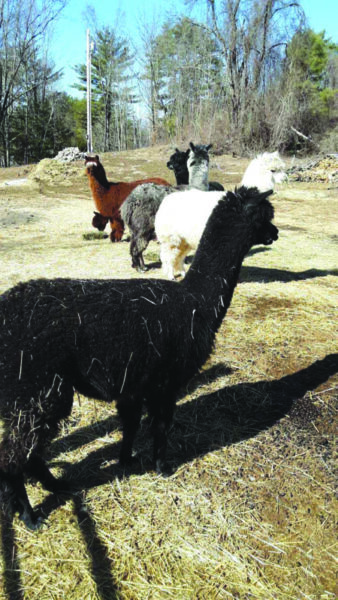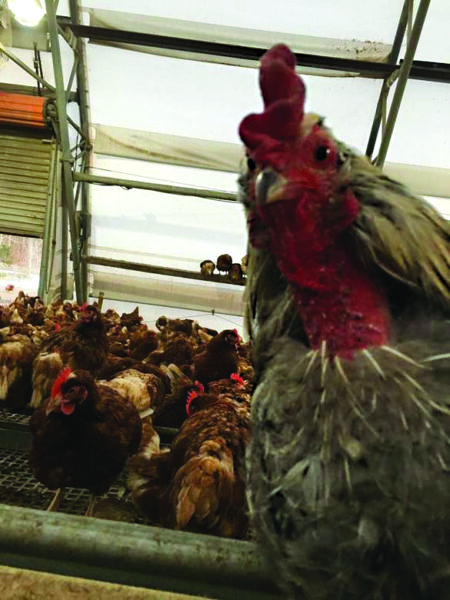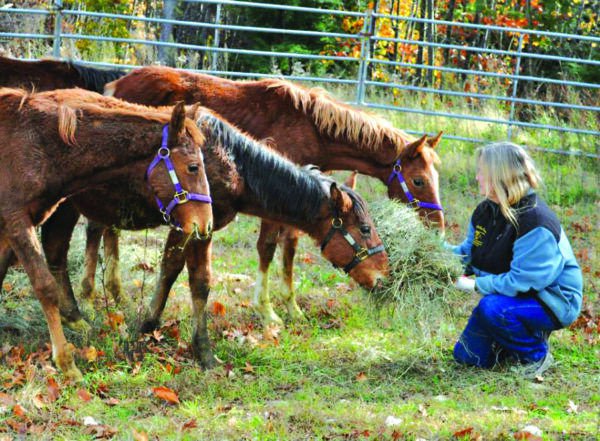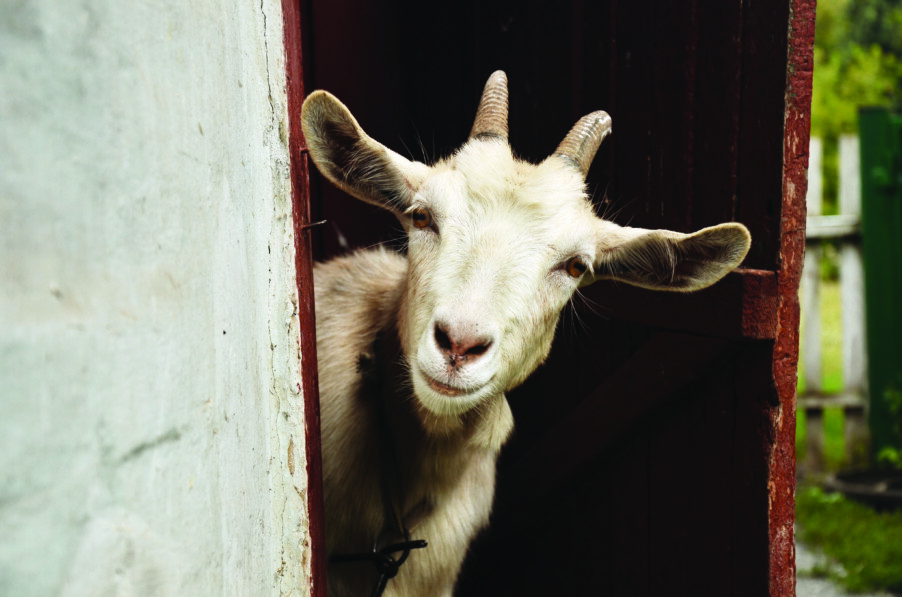Why you might want to add a companionable kid, some laid-back alpacas and other animals to your family
Maybe you’ve dreamed of owning goats that could mow your lawn, a donkey for companionship, or snails that will suck the algae off your fish tank. New Hampshire animal owners and caretakers shared their expertise on nine non-traditional “pets” and what it takes to give them a proper home. Note that zoning laws and rules about keeping nontraditional animals may vary by community, so be sure to check with your town or city hall before purchasing a new animal or altering your property.
Alpacas

Why you might want them: Not to be confused with llamas, alpacas are much smaller animals that were bred specifically for their fiber rather than for packing.
“Llamas have fiber, but mostly only around their mid-waist. Alpacas are strictly fiber animals,” said Barbie Tilton of Someday Farm in Canterbury, which is currently home to six alpacas.
According to Sandy Warner of Granite State Alpacas, based in Hampton Falls, alpacas are considered the easiest large livestock animal to care for because they require the least input from owners.
“[They] are hypoallergenic animals and their fiber and finished products are ideal for anyone who has wool allergies,” Warner said in an email. “Their coats are also naturally wicking, odor-resistant, and anti-static.”
There are two fleece types, according to Wendy Lundquist of Snow Pond Farm in Windham — Suri, which is characterized by its dreadlock-like fibers, and Huacaya, which look more like fluffy teddy bears.
What they do most of the time: According to Megan Long, whose family owns Nodrog Farms in Barrington, alpacas are very laid back animals that mostly eat, sleep or sunbathe in warm weather.
“Occasionally you will see them pronking around the yard, but mostly they are an easygoing animal,” Long said.
Ideal amount of space: Like with any other herd animals, Warner said the more space the better. Multiple pastures are ideal, with separate pastures to keep males and females apart.
“I’d say two [alpacas] are good, but three is company. The more the merrier,” Tilton said. “They like to be in a herd with a whole bunch of other alpacas.”
Smallest possible amount of space: Warner said she recommends at least one acre per two to three alpacas.
Their needs: Alpacas need shelter from wind and the elements, with at least a run-in shelter if not also a barn.
“They need to be shorn once a year, or they can be overheated in the summer wearing their winter wool,” Warner said.
Tilton said her alpacas also get ivermectin shots at least every 30 days, to protect them from a deadly parasite known as the meningeal worm that passes through feces in deer.
What you need to do for them: Alpacas should always have fresh hay, fresh water, grain, mineral supplements, toenail trimming and annual shearing. Similar to cats, Warner said, they can be aloof by nature.
“The more time you spend with them the more social they become,” she said.
Cost (of animal and upkeep): Long said that, on average, it costs about $500 per year for each individual animal.
Lifespan: Alpacas can live up to 20 years or longer, according to Warner.
Occasional animal: You can also contact a local alpaca farm or animal shelter to see if they have any alpacas that may need to be fostered, Long said.
Just looking: Some farms, including both Someday Farm, Snow Pond Farm and Nodrog Farms, welcome visitors if you contact them ahead of time. Others have also visited local farmers markets in the past — Everything Alpaca of Milford, for example, has brought its alpacas to the Milford Farmers Market.
Chickens
Why you might want them: Matt Gelbwaks of Julie’s Happy Hens in Mont Vernon said the benefits of chickens are that the hens will give you an egg a day, year-round; they produce high-quality fertilizer; they will remove bugs and grubs from around your garden and outdoor plants; and they are “mostly docile and pleasant … and Instagram-ready.”
What they do most of the time: Gelbwaks said chickens mostly wander around, investigating their surroundings, occasionally stopping to “dust bathe,” a form of self-cleaning in which they roll around in the dirt, then vigorously shake the dirt off. This helps them to remove any harmful bugs or parasites, keep their feathers clean by removing excess oil and shed old feathers.
Their needs: The ideal amount of space for chickens is 3 square feet per bird, or letting them free range on your whole yard.
“The more space they have, the less harsh they will be on their space,” Gelbwaks said. “If you give them the minimum, they will eat everything and reduce it to a dust bowl within a month or two.”
You could manage with as little as 1 to 2 square feet per bird, but only if you’re prepared to give them lots of attention.
“If you talk to them every day and remind them that you are taking care of their every need, they will be happy [with less space],” Gelbwaks said. “The less you actively engage with them, the more space they will need.”
Because chickens are prey animals, they need some kind of draft-free shelter in their space where they can hang out and sleep safely, out of reach of predators.
“They need a place to hide and feel secure,” Gelbwaks said. “Lots of things scare them.”
Their food and water should be in close proximity to the shelter. They need about one-third to one-half a pound of chicken feed a day, with some additives, such as oyster shell, for the aging chickens. As for their water, a simple dish is fine, but expect to have to “change it constantly,” Gelbwaks said, as chickens tend to dirty water very quickly.
What they cost: You can buy a baby chick for just a couple of bucks, though the price goes up if you’re looking into “rare, fancy ones,” Gelbwaks said. Hens range from $10 to $30, depending on their age; pullets — hens that are just about to hit egg-laying age — are on the higher end, while older hens are on the lower end. The initial setup could be as inexpensive as $50, depending on what kind of space you’re working with, but, Gelbwaks said, the sky’s the limit on how elaborate you want to get.
“Many people pay way too much and get ultra-fancy coops that rival their kids’ playhouses,” he said.
Their lifespan: Three to five years, depending on the breed.
If you aren’t ready to commit: You can rent chickens, Gelbwaks said, but once they’ve lived on a private property it’s nearly impossible to reintegrate them into a commercial flock, so they’ll most likely get culled. If you just want to see some chickens, most local farms are happy to accommodate, Gelbwaks said.
Goats

Why you might want them: Goats can be fun companion animals that are easy to care for, just as long as you have a good fence to keep them in, said Teresa Paradis, founder and executive director of Live & Let Live Farm in Chichester. Goats can also be kept for a variety of reasons, from their milk to their meat or fiber.
What they do most of the time: Goats love hiking and spending time with their human companions, Paradis said. They love eating brush, poison ivy, unwanted thorn bushes and other problem growth you’d like to get rid of naturally without the use of pesticides.
Ideal amount of space: The more space you have the better. Noreen Rollins of Tilton Hill Goat Farm in Danbury said it’s best to have at least 5 acres of space available for goats.
According to Briana Desfosses of Fox’s Pride Dairy Goats in Mont Vernon, goats tend to prefer wooded areas or areas with brush.
“They don’t need nearly the [same] amount of space as sheep or other larger animals like horses or cows,” she said. “Many people keep a small handful of pet goats in their backyard.”
Smallest possible amount of space: Paradis said because goats are herding animals, it’s ideal to house at least between two to three of them together.
“You could house several goats on less than 2 acres of land and a proper enclosure [or] barn as long as they are allowed … in your city or town,” she said.
Their needs: A goat’s main source of food is shrubbery and hay. Paradis said they should also be checked for parasites and treated with an ivermectin injection yearly. Hoof trimming care can be done every few months, depending on the space they have to move around in that would wear their hooves down.
What you need to do for them: Rollins said goats require sufficient feed and shelter, and their fibers should be removed at least once a year.
Cost (of animal and upkeep): Depending on the natural food sources you have available, Paradis said the average goat may cost approximately $40 to $50 per month.
For goats that are producing milk, Desfosses said you’ll likely be spending a lot more on grain, as well as all sorts of supplements and veterinary care.
Lifespan: Goats typically live anywhere from 12 to 20 years, according to Paradis.
Occasional animal: Some local shelters, like Live & Let Live Farm and the New Hampshire SPCA, may have opportunities to adopt or foster farm animals, including goats. A few spots, like Gap Mountain Goats of Marlborough, have even offered their goats up for rent to eat your poison ivy, weeds or other unwanted vegetation, while at Jenness Farm in Nottingham there are baby goat yoga classes available for adults. Desfosses said some herds may lease their animals to partake in 4-H youth shows.
Just looking: Sunday guided tours at Live & Let Live Farm were temporarily suspended due to the pandemic, but according to Paradis, they will likely start back up in mid-June. Other spots, like Tilton Hill Goat Farm, may open to visitors with prior notice.
Guineafowl
Why you might want them: Guineafowl lay eggs seasonally, from May through September, Gelbwaks said, and the eggs are made up of a different protein than chicken eggs, making them safe for most people with regular egg allergies to eat. They eat ticks, and they are usually the first to alert you if there is something amiss on your property. That being said, they are also “loud, noisy and obnoxious,” Gelbwaski said.
“It takes a particular seriousness to want to keep guineas,” he said, adding that they can also be a bit dimwitted. “They run around and often forget they have wings and need to be let into a gate they just flew over.”
What they do most of the time: Run around, “looking for things to bark at,” Gelbwaski said, and digging around for bugs and seeds to eat.
Their needs: Guineas hate being contained and need to be able to roam free, Gelbwaks said. “They go where they want, and once they pattern on your roosting space, they come back,” he said. “Some hang out on our property while others range a mile or so.”
You still need to provide a draft-free shelter for the guineas to find refuge from predators and to roost. Give them water, and supplement their foraging with some feed.
What they cost: They only cost a few bucks, but it’s essential that you buy them as keets (babies) if you want them to stay on your property, Gelbwaks said.
“It’s really hard to repattern adult guineas,” he said. “If you want to start a flock, get keets and rear them in the location you want them to pattern to.”
Their lifespan: About five years, assuming they don’t get snatched up by a predator, which they often do, Gelbwaks said.
If you aren’t ready to commit: “Again, you can’t repattern adults, so once you get them you’re kind of stuck with them,” Gelbwaks said. If you want to see what guineas are like, your best bet is to visit a local farm that has them.
Horses, ponies and donkeys

Why you might want them: Horses and ponies may be among the more costly animals to own but are also among the most spiritual and intelligent, according to Paradis. Ponies should not be confused with mini horses, which have been bred down to size through the years to produce smaller breeds.
Donkeys are also highly intelligent and have a strong sense of self-preservation, said Ann Firestone, president and co-founder of Save Your Ass Long Ear Rescue in South Acworth.
“As a rule, they are very friendly, people-oriented animals that have often been described as therapeutic due to their gentle, patient nature,” she said.
What they do most of the time: Horses and donkeys like to spend their time grazing — in the natural world, Paradis said, horses move around and graze for about 20 hours a day, sleeping for about three to four hours in 15- to 20-minute increments during the day.
Ideal amount of space: The average stall for horses and donkeys is 10 by 10 feet. Ideally, they should have at least one acre of space.
Smallest possible amount of space: At a minimum, Paradis said horses should have a sturdy three-sided shelter with a roof that they can freely move in and out of at will, or even a barn with an outside door that can lead into the pasture. The outside space, similarly, should be at least large enough for them to get into a good run to stretch, roll and play in.
“A dry lot area with a nice pasture to go out in is ideal,” she said.
Their needs: Paradis said you need to have a good source of hay. An average-sized horse eats an average-sized bale of hay, around 40 to 45 pounds, every two days, with ponies and mini horses eating much less. Donkeys, according to Firestone, have a diet of hay, barley straw and a vitamin-mineral supplement.
What you need to do for them: Jade Place of Weare, who adopted her pet horse from Live & Let Live Farm in 2001, said regular upkeep includes hoof trimming every six to eight weeks, as well as ongoing monitoring for parasites and yearly dental checks. Horses and ponies also need to be kept dry during inclement weather to prevent fungal infections such as rain rot.
Generally, if there are no emergencies, a horse is seen by its equine veterinarian about once a year. They should be checked over daily for things like cuts and ticks.
Cost (of animal and upkeep): For donkeys, Firestone said annual vaccinations will run you about $200 and dental visits at $100 or more. The cost of feed will depend on the size of your animal.
Lifespan: Donkeys live for about 30 years on average, Firestone said. Paradis said horses can live 30 to 40 years or more.
Occasional animal: Live & Let Live Farm offers horse fostering, which includes inspections for appropriate homes and facilities. Many other local farms and ranches offer horse or pony rides and lessons.
Just looking: Firestone said Save Your Ass Long Ear Rescue allows visitors by appointment only — appointments can be made by calling, emailing or sending a message on social media. Live & Let Live Farm is also expected to resume its weekly guided tours later this month.
Peafowl
Why you might want them: Gelbwaks said peafowl such as peacocks are “an acquired taste and a commitment.”
“They have very individual personalities but don’t often really like to socialize,” he said. “They are, however, quite striking to look at.”
What they do most of the time: Male peafowl are very vain, Gelbwaks said, and spend most of their time preening and trying to look good, while the female peafowl are very dismissive and spend most of their time playing hard-to-get with the male peafowl.
Their needs: Peafowl like to travel and need to be able to free range.
“You can keep a pea in a large cage, but they do not flourish, and they tend to mope and be unhappy all of the time,” Gelbwaks said.
They need food, water and a draft-free shelter where they can keep their feet out of the snow, since they are very susceptible to frostbite.
If you’re looking to spoil them, Gelbwaks said, feed them cheese.
“No one knows why, but peas seem to love cheese,” he said. “It’s the only thing they’ll eat out of our hands, and when they see us with some, they’ll come running from wherever they are.”
Peas also have a strong need for attention and adoration, “even if it’s just the occasional encouragement on their fanned tails or nicely groomed feathers,” Gelbwaks said.
“Don’t expect anything in return,” he said. “Secretly, they always harbor the desire to come and nuzzle, but peer pressure won’t allow them to do so.”
What they cost: Peafowl eggs can cost $10 to $30 per egg and are “notoriously hard to hatch” and keep alive during the first week, Gelbwaks said. Chicks can cost $25 to $50 each. Adults may cost $100 to $500, depending on their coloring.
Their lifespan: 25 to 40 years in the wild, but may be shorter when domesticated.
If you aren’t ready to commit: “Many zoos and parks have them in residence,” Gelbwaks said. “It’s best to go visit them there.”
Pigs

Why you might want them: Pigs are one of the smartest animals you can own as a pet and, contrary to the stereotype of a pig pen being messy, are actually very clean animals, said Holly Kimball of Beech Hill Farm in Hopkinton.
What they do most of the time: According to Kimball, many hours of a pig’s day are spent resting or sunbathing. A layer of mud or dirt that a pig may roll around in actually acts as a form of sunscreen, she said, because their skin sunburns very easily.
Rachel Savoie and her husband Kyle of Nashua adopted a pet pig named Cindy Lou from the New Hampshire SPCA two years ago. She said Cindy Lou, who is estimated to be about 3 years old, will sleep for a majority of the day and will often burrow underneath blankets.
“She has a whole bedroom, and at night she likes to roam around,” she said.
Ideal amount of space: Kimball said pigs require enough space to exercise, and they also need a designated bathroom area that is well apart from their eating and sleeping areas.
Their needs: Because of their skin pigmentation, pigs must always have protection from the sun.
What you need to do for them: Kimball said it’s important for piglets to be wormed and receive certain shots according to veterinarian recommendations. They also need clean bedding, ample grain, fresh water and shelter.
Savoie said her pet pig’s diet includes pig pellets, a large serving of fruits and vegetables, like tomatoes, cucumbers and carrots, and candied peppermints as treats.
“Her hooves are trimmed twice a year, and she goes to the vet once a year for a regular visit,” she said.
Cost (of animal and upkeep): Between the food and medical care, Savoie estimated the overall upkeep of a pet pig to be more than that of a dog each year. Kimball said it can be even more expensive if you’re raising pigs for the purpose of meat.
Lifespan: Savoie said a pig’s lifespan is between 15 and 20 years, depending on the breed type.
Occasional animal: You can contact a local farm or animal shelter to see if they have any pigs that may need to be fostered.
Just looking: During Beech Hill Farm’s summer season, which began May 1 and runs through Oct. 31, visitors are welcome to come see and learn about each of the farm animals. Other local farms with pigs may welcome visitors if you contact them ahead of time.
Rabbit snails
Why you might want them: “Some people like collecting different snails and critters,” said Michael Gioia, owner of Fish Mike Aquatics in Manchester. “Others may use them inside aquariums as a cleanup crew to eat algae and uneaten fish food.”
What they do most of the time: Crawl around, sometimes burrowing into the sand.
Their needs: These freshwater aquatic snails need a 10- to 20-gallon tank, Gioia said, with specific water temperatures and pH levels, depending on the species.
“An owner would require a cycled aquarium, as well as basic aquarium care knowledge to keep them healthy,” he said.
You can feed them regular commercial food used for fish and snails.
What they cost: A 20-gallon aquarium setup starts at around $100, which includes a filter, heater, tank, some gravel and a cheap light, Gioia said, but more elaborate setups can get expensive. The ongoing cost is minimal — just enough to cover food, replacement filters and water additives.
Their lifespan: 1 to 3 years.
If you aren’t ready to commit: You can go check them out at a public aquarium or local pet store that sells aquariums, Gioia said.
Worms
Why you might want them: Certain types of worms, like red wigglers, can be used for composting.
Joan O’Connor, a worm composter in Henniker, said you can feed worms non-citrus fruits, vegetables, eggshells, coffee grounds, tea bags, paper products and other organic waste that would otherwise get thrown in the trash.
“They could eat and process a pound of garbage in a week or so,” she said. “They’re your workers.”
Not only are you doing something good for the environment, O’Connor said, but you’re also rewarded with a rich, natural fertilizer for your personal use.
“You can take handfuls of this stuff and add it to your houseplants, your tomato plants, your gardens, your rhododendron bush outside,” she said.
What they do most of the time: “They just sit there, hang out, and eat your garbage … and if you keep them happy, they’ll reproduce,” O’Connor said.
Their needs: For your initial setup, O’Connor said, get a large plastic storage container that’s a couple of feet deep and drill some holes in the bottom for excess moisture to drain. Fill it with alternating layers of shredded newspaper and peat moss. Lay a window screen, mesh or thin fabric over the top of the container and wrap a bungee cord around it to keep the worms from escaping.
The key to keeping your worms alive, O’Connor said, is maintaining a temperature between 60 and 80 degrees.
“They’re very low-maintenance, but you’ve got to watch that temperature,” she said. “If they get too cold or too hot they’ll start to slow down.”
You don’t have to think too hard about how much you feed them, O’Connor said; worms don’t need to eat as much as they like to eat.
“If anything, overfeed them,” she said. “It makes them happy, and it makes them step up and keep [composting] for you.”
What they cost: A pound of worms, which is a good starting amount, O’Connor said, ranges from $20 to $50 online.
Their lifespan: An individual worm lives for weeks to months but will reproduce, so you’ll always have worms.
If you aren’t ready to commit: Try them out, and if it’s not for you, you should have no difficulty finding someone to take your worms off your hands, O’Connor said.
“Give them to a science teacher, a garden club, your neighbor, anyone with a green thumb,” she said.





